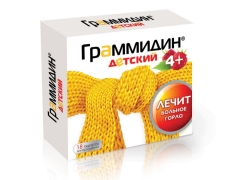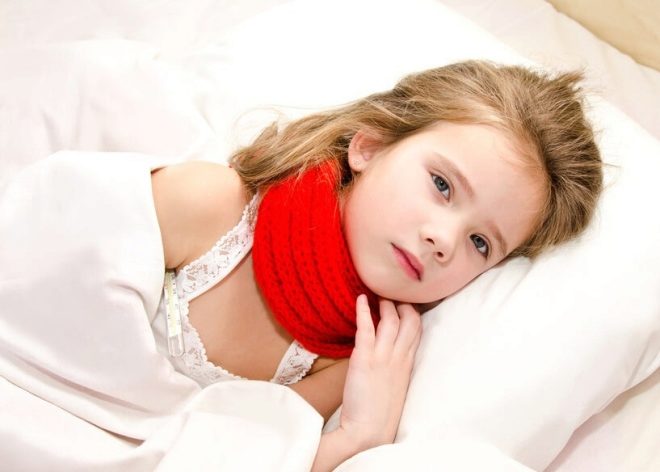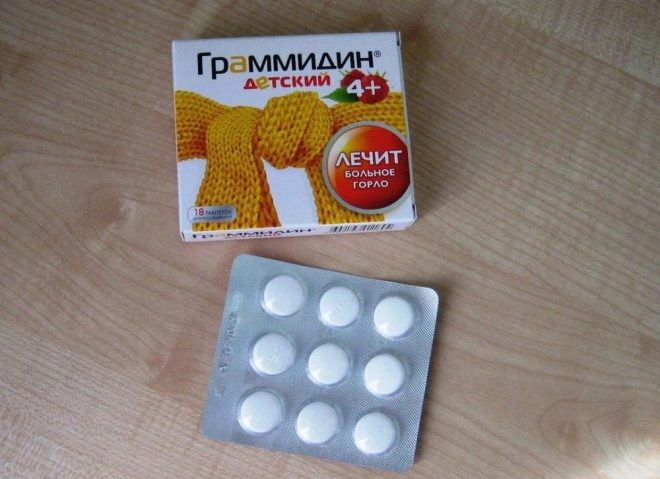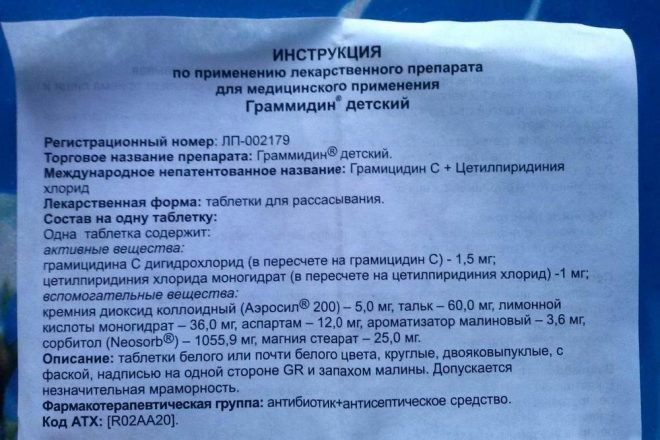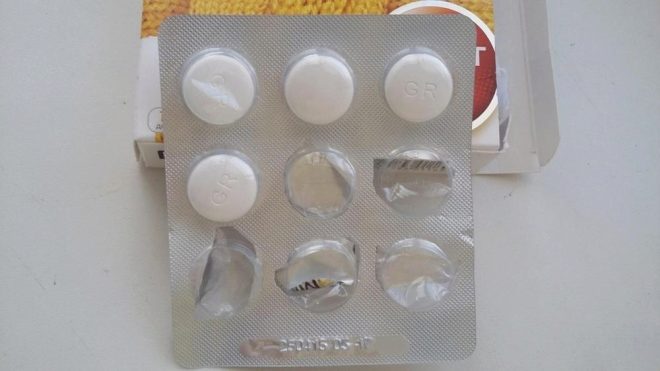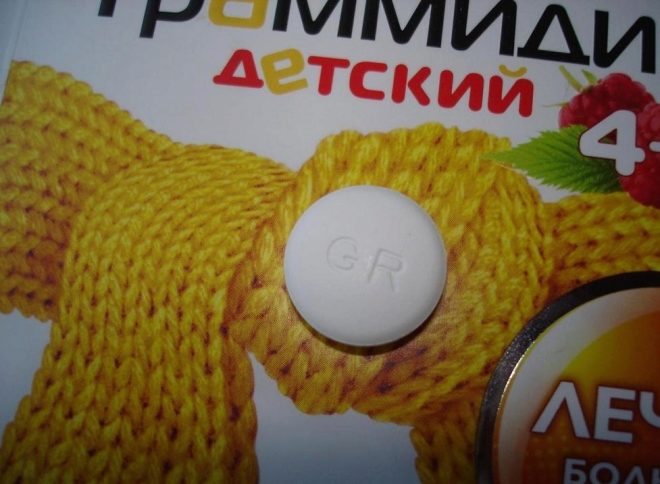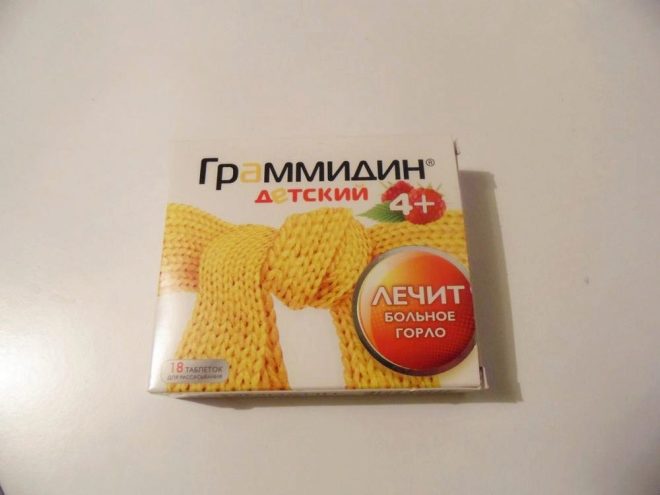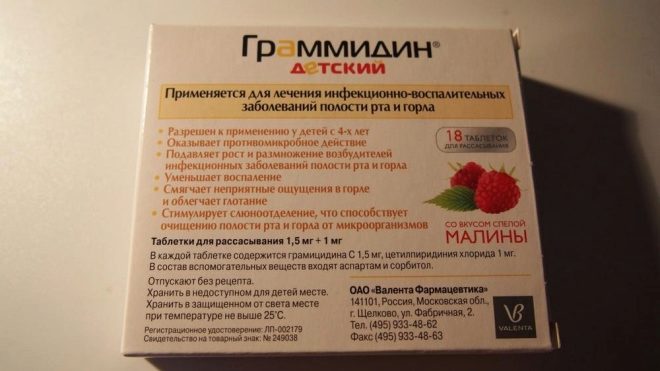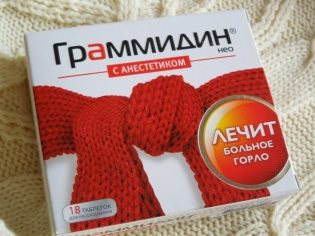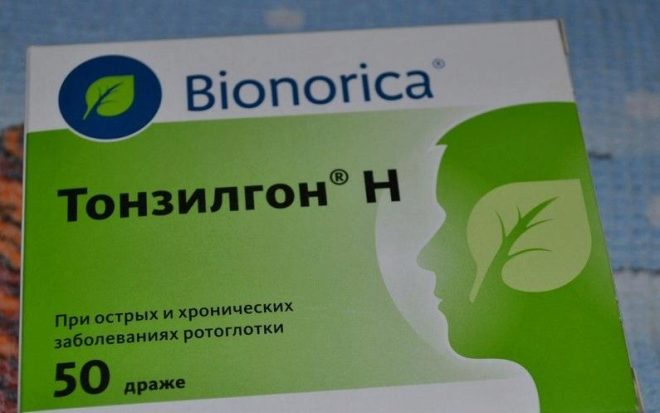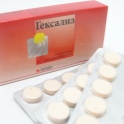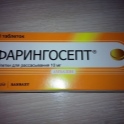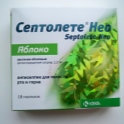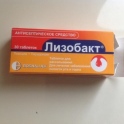Grammidin children
For diseases of the throat and oral cavity are very popular and often used drugs that need to dissolve in the mouth. One of them is Grammidin. It is a drug that includes two ingredients aimed at combating inflammation, infectious agents and sore throat. Especially for children Grammidin is issued for children. Is it permitted at an early age, when it is used and which analogs can be replaced if necessary?
Release form
Grammidine is produced in the form of white tablets (sometimes with a marble tinge) that smell like raspberries. They have a round shape and have the inscription GR on one of the sides. One blister can include either 6 or 9 tablets. One carton pack contains 12, 18 or 24 tablets.
Composition
Grammidine action provides two active ingredients at once:
- Gramicidin C. This substance is presented in the preparation in the form of dihydrochloride, but its dose in terms of the active ingredient is 1.5 mg per 1 tablet.
- Cetylpyridinium chloride. The amount of this component in one tablet is 1 mg.
They are supplemented with excipients such as citric acid (represented by monohydrate), sorbitol, and aspartame. In addition, the composition of the tablets contains magnesium stearate, colloidal silicon dioxide and talc. A pleasant smell to the medicine gives a raspberry flavor. All these additional components are important to consider if the pills are prescribed allergies.
Operating principle
Grammidine refers to the combination drugs with antiseptic and antibacterial effect.
Its therapeutic effect is due to such features of its ingredients:
- Gramicidin C in the composition of the tablets is an antimicrobial substance that affects the cytoplasmic membrane in the cells of harmful microorganisms. Such an antibiotic increases their permeability, with the result that the stability of the membrane is broken, and the microbial cells die. At the same time, gramicidin C has a very wide range of effects on gram-positive microorganisms and on the gram-negative flora.
- The second active ingredient of the drug, cetylpyridinium chloride, has antiseptic properties, which helps gramicidin C to eliminate infectious agents in the oral cavity, inhibiting their reproduction and growth. This substance also has anti-inflammatory effects.
When resorption pills medication not only inhibits pathogens and reduces the severity of the inflammatory process, but also stimulates a more active release of saliva. As a result of this hypersalivation, swallowing is easier, and discomfort in the throat is softened. Thus, the oral cavity is additionally mechanically cleared of bacteria and their toxins.
Indications
The drug is recommended to dissolve with pain in the throat and mouth, if they are one of the symptoms of infection of the oropharynx.
Grammydin is in demand for:
- Stomatitis
- Gingivitis.
- Angina
- Laryngitis
- Parodontitis.
- Tonsillitis.
- Pharyngitis.
- Laringofaringite.
At what age is it allowed to take?
The instructions for the children's version of Grammeadin noted that the drug is not used in children under the age of four. If a child is not yet 4 years old, it is better to use other medicines in his treatment.
Contraindications
Tablets do not give not only children under 4 years old, but also a child with hypersensitivity to any of the ingredients of the medication. You should also not prescribe this medication for phenylketonuria, because its composition includes aspartame. In addition, it is not recommended to dissolve Grammidin children when open wounds in the oral cavity, since cetylpyrinium chloride will slow down the process of their healing. Adults do not prescribe the drug during breastfeeding.
Side effects
Grammidine's use of children can cause digestive upset in the form of diarrhea or nausea. In addition, some children have an allergic reaction to this medication. The occurrence of these signs of intolerance should be the reason for going to the doctor and replacing the pills with another medication.
Instructions for use and dosage
- The drug is given to the child only after a meal.
- The tablet should be kept for a long time in the mouth, so that it dissolves very slowly and affects the mucous membrane.
- Chew this medicine should not be, because it will affect its therapeutic effect.
- After the medication is completely dissolved, you should not eat or drink anything for at least 1 hour, or better for 2 hours.
- In childhood Grammidin give 4 times a day.
- A child of 4-12 years old will be one tablet in a single dose.
- Children over 12 years old give two tablets at one time. The second is used 20-30 minutes after the child has dissolved the first pill.
- The maximum permissible dose of medication per day for children under 12 years old is four tablets, and for a teenager over 12 years old - 8 tablets.
- If the child takes the medication for a week and there is no positive effect from the medication, you should consult a doctor.
Overdose
If you exceed the recommended daily dose of tablets, it will adversely affect the work of the gastrointestinal tract, because it can cause changes in the bacterial microflora of the intestine. The result will be nausea, loose stools or vomiting. When such symptoms occur, the pill is immediately canceled and referred to a pediatrician.
Interaction with other drugs
There are no data on any incompatibility of Grammidin with other drugs. Such a drug is often prescribed in combination with other drugs, for example, when tonsillitis is given, the child is prescribed Grammidin Tonsilgon N at the same time.
Terms of sale
Grammidine in the pediatric dosage is referred to over-the-counter medication, so it can be easily purchased at most pharmacies. The average price of a pack of 18 tablets is 220-230 rubles.
Storage features
Keep Grammidin children’s at home should be in a dry place so that the drug is inaccessible to a small child. The storage temperature of such drugs should not be above +25 degrees Celsius. The shelf life of the drug is 2 years. If the date on the packaging is erased or the expiration date has expired, it is unacceptable to give tablets to the child.
Reviews
About the use of Grammidin in mom's children respond mostly positively. Drug praise for availability in pharmacies, pleasant taste and a minimum of contraindications. According to parents, the drug quickly eliminates pain, helps with cough caused by discomfort in the throat, and also accelerates recovery.
Only rarely did an allergic reaction occur on the pills or digestive disorders appeared. In most cases, children tolerate such a tool well, and they like the taste of tablets. As for the cost, many mothers call the price of Grammidin a low one, so the drug is rarely looked for cheaper.
Analogs
In addition to the children's Grammydin, the same manufacturer offers other options for such a drug:
- Grammeidine neo. A feature of such tablets is a higher concentration of the antimicrobial ingredient (gramicidin C in each such tablet is represented by a dosage of 3 mg).The drug has a mint taste and smell, and instead of aspartame it contains another sweetener - acesulfame potassium. This allows you to assign it with phenylketonuria. In childhood Grammidin neo used from 4 years. The child is given 1 tablet 1-2 times a day at the age of 12 years and one tablet three to four times a day during adolescence.
- Gramidin neo with anesthetic. Due to the presence in the composition of such tablets oxybuprocaine, they have a pronounced analgesic effect. Like the drug without anesthetic, it is white mint tablets with acesulfame potassium as a sweetener. This medication is also allowed from 4 years of age and is prescribed for children, 1-2 tablets per day up to 12 years of age and 3-4 tablets per day for children over 12 years old (1 tablet per reception).
Grammidin can also be replaced by drugs with a different composition, but with a similar therapeutic effect, for example:
- Lizobact. These tablets contain lysozyme, which is a natural compound that protects the oral mucosa from bacteria. Due to the second component (pyridoxine), the drug accelerates the healing of mucosal injuries, which is especially needed for aphthous stomatitis. The drug is prescribed to dissolve children older than 3 years.
- Faringosept. These inexpensive pills have an antiseptic effect and inhibit bacteria, therefore they are prescribed for sore throat, gingivitis, tracheitis, pharyngitis and other pathologies. Children can be given to dissolve from the age of three.
- Tonsilgon N. This drug is made from medicinal plants - oak bark, walnut leaves, Althea roots, chamomile flowers, dandelion grass, horsetail and yarrow. It is produced in liquid form (drops) and in pills. The drug is prescribed for tonsillitis, laryngitis and other diseases. In this case, the drops are allowed to give to children older than a year, and the solid form is used in the treatment of children over 6 years old.
- Hexalysis. The composition of such lozenges includes lysozyme, enoxolone and biclotymol. Such components have an antiseptic effect, reduce pain and help to quickly get rid of the inflammatory process. The drug is used in pediatrics from the age of six.
- Supra-lor As part of this antiseptic for throat amylmetacresol supplemented with dichlorobenzyl alcohol. The drug is produced with a different taste and is prescribed to children over six years old with stomatitis and inflammatory diseases of the respiratory tract (upper part).
- Septolete. This product contains oils of peppermint and eucalyptus, benzalkonium chloride, levomenthol and thymol. These ingredients provide the drug with antiseptic properties. Doctors prescribe such lozenges to children over 4 years old with tonsillitis, stomatitis, laryngitis, and other lesions of the throat and mouth. Septolete Neo is produced separately (it contains only cetylpyrinium chloride and is used from 4 years), Septolete D (the same composition as Septolete, but without sugar) and Septolete total (includes cetylpyrinium chloride and the anti-inflammatory component represented by benzidamine, is assigned from 12 years ).
Watch the transfer of Dr. Komarovsky, from which you will learn about the causes of sore throat in a child.
